Analysis of a Stochastic SICR Epidemic Model Associated with the Lévy Jump
Abstract
:1. Introduction
2. Existence and Uniqueness of the Global Positive Solution
3. Extinction of the Infection
4. Persistence in the Mean
5. Numerical Results
6. Conclusions
Author Contributions
Funding
Institutional Review Board Statement
Informed Consent Statement
Data Availability Statement
Conflicts of Interest
References
- World Health Organization HIV/AIDS Key Facts. November 2017. Available online: http://www.who.int/mediacentre/factsheets/fs360/en/index.html (accessed on 5 July 2022).
- Allali, K.; Danane, J.; Kuang, Y. Global analysis for an HIV infection model with CTL immune response and infected cells in eclipse phase. Appl. Sci. 2017, 7, 861. [Google Scholar] [CrossRef] [Green Version]
- Korobeinikov, A. Global properties of basic virus dynamics models. Bull. Math. Biol. 2004, 66, 879–883. [Google Scholar] [CrossRef] [PubMed]
- Nowak, M.A.; Bangham, C.R.M. Population dynamics of immune responses to persistent viruses. Science 1996, 272, 74–79. [Google Scholar] [CrossRef] [PubMed] [Green Version]
- Smith, H.L.; De Leenheer, P. Virus dynamics: A global analysis. SIAM J. Appl. Math. 2003, 63, 1313–1327. [Google Scholar] [CrossRef]
- Sun, Q.; Min, L.; Kuang, Y. Global stability of infection-free state and endemic infection state of a modified human immunodeficiency virus infection model. IET Syst. Biol. 2015, 9, 95–103. [Google Scholar] [CrossRef] [PubMed] [Green Version]
- Kermack, W.O.; McKendrick, A.G. A contribution to the mathematical theory of epidemics. Proc. R. Soc. Lond. Ser. A Math. Phys. Engrg. Sci. 1927, 115, 700–721. [Google Scholar]
- Qiao, M.; Liu, A.; Forys, U. Qualitative analysis of the SICR epidemic model with impulsive vaccinations. Math. Methods Appl. Sci. 2013, 36, 695–706. [Google Scholar] [CrossRef]
- Rajaji, R.; Pitchaimani, M. Analysis of stochastic viral infection model with immune impairment. Int. J. Appl. Comput. Math. 2017, 3, 3561–3574. [Google Scholar] [CrossRef]
- Akdim, K.; Ez-Zetouni, A.; Danane, J.; Allali, K. Stochastic viral infection model with lytic and nonlytic immune responses driven by Lévy noise. Phys. A Stat. Mech. Its Appl. 2020, 549, 124367. [Google Scholar] [CrossRef]
- Mahrouf, M.; El-Mehdi, L.; Mehdi, M.; Hattaf, K.; Yousfi, N. A stochastic viral infection model with general functional response. Nonlinear Anal. Differ. Equ. 2016, 4, 435–445. [Google Scholar] [CrossRef]
- Pitchaimani, M.; Brasanna, D.M. Effects of randomness on viral infection model with application. IFAC J. Syst. Control 2018, 6, 53–69. [Google Scholar] [CrossRef]
- Zhang, Q.; Zhou, K. Stationary distribution and extinction of a stochastic SIQR model with saturated incidence rate. Math. Probl. Engrg. 2019, 2019, 3575410. [Google Scholar] [CrossRef]
- Mao, X. Stochastic Differential Equations and Their Applications; Horwood Publishing Series in Mathematics and Applications; Horwood Publishing Limited: Chichester, UK, 1997; 2nd ed.; Woodhead Publishing Limited: Oxford, UK; Cambridge, UK; Philadelphia, PA, USA; New Delhi, India, 2011. [Google Scholar]
- Weiss, R.A. How does HIV cause AIDS? Science 1993, 260, 1273–1279. [Google Scholar] [CrossRef] [PubMed]
- Bao, J.; Mao, X.; Yin, G.; Yuan, C. Competitive Lotka-Volterra population dynamics with jumps. Nonlinear Anal. 2011, 74, 6601–6616. [Google Scholar] [CrossRef] [Green Version]
- Momani, S.; Kumar, R.; Srivastava, H.M.; Kumar, S.; Hadid, S. A chaos study of fractional SIR epidemic model of childhood diseases. Results Phys. 2021, 27, 104422. [Google Scholar] [CrossRef]
- Srivastava, H.M.; Günerhan, H. Analytical and approximate solutions of fractional-order susceptible-infected-recovered epidemic model of childhood disease. Math. Methods Appl. Sci. 2019, 42, 935–941. [Google Scholar] [CrossRef]
- Bao, J.; Yuan, C. Stochastic population dynamics driven by Lévy noise. J. Math. Anal. Appl. 2012, 391, 363–375. [Google Scholar] [CrossRef] [Green Version]
- Blanttner, W.; Gallo, R.C.; Temin, H.M. HIV causes aids. Science 1988, 241, 515–516. [Google Scholar] [CrossRef]
- Srivastava, H.M.; Dubey, R.S.; Jain, M. A study of the fractional-order mathematical model of diabetes and its resulting complications. Math. Methods Appl. Sci. 2019, 42, 4570–4583. [Google Scholar] [CrossRef]
- Srivastava, H.M. Diabetes and its resulting complications: Mathematical modeling via fractional calculus. Public Health Open Access 2020, 4, 2. [Google Scholar] [CrossRef]
- Mahrouf, M.; Boukhouima, A.; Zine, H.; Lotfi, E.; Torres, D.F.M.; Yousfi, N. Modeling and forecasting of COVID-19 spreading by delayed stochastic differential equations. Axioms 2021, 10, 18. [Google Scholar] [CrossRef]
- Srivastava, H.M.; Saad, K.M. Numerical simulation of the fractal-fractional Ebola virus. Fractal Fract. 2020, 4, 49. [Google Scholar] [CrossRef]
- Singh, H.; Srivastava, H.M.; Hammouch, Z.; Nisar, K.S. Numerical simulation and stability analysis for the fractional-order dynamics of COVID-19. Results Phys. 2021, 20, 103722. [Google Scholar] [CrossRef] [PubMed]
- Mao, X.; Marion, G.; Renshaw, E. Environmental Brownian noise suppresses explosions in population dynamics. Stochast. Process. Appl. 2002, 97, 95–110. [Google Scholar] [CrossRef]
- Silva, C.J.; Torres, D.F.M. A SICA compartmental model in epidemiology with application to HIV/AIDS in Cape Verde. Ecol. Complex. 2017, 30, 70–75. [Google Scholar] [CrossRef] [Green Version]
- Srivastava, H.M.; Saad, K.M.; Khader, M.M. An efficient spectral collocation method for the dynamic simulation of the fractional epidemiological model of the Ebola virus. Chaos Solitons Fractals 2020, 140, 110174. [Google Scholar] [CrossRef]
- Zhang, X.; Wang, K. Stochastic model for spread of AIDS driven by Lévy noise. J. Dyn. Differ. Equ. 2015, 27, 215–236. [Google Scholar]
- Srivastava, H.M.; Saad, K.M.; Gómez-Aguilar, J.F.; Almadiy, A.A. Some new mathematical models of the fractional-order system of human immune against IAV infection. Math. Biosci. Engrg. 2020, 17, 4942–4969. [Google Scholar] [CrossRef]
- Zine, A.; Boukhouima, H.; Lotfi, E.; Mahrouf, M.; Torres, D.F.M.; Yousfi, N. A stochastic time-delayed model for the effectiveness of Moroccan COVID-19 deconfinement strategy. Math. Model. Natur. Phenom. 2020, 15, 50. [Google Scholar]
- Zou, X.; Wang, K. Numerical simulations and modeling for stochastic biological systems with jumps. Commun. Nonlinear Sci. Numer. Simulat. 2014, 19, 1557–1568. [Google Scholar]
- Lipster, R.S. A strong law of large numbers for local martingales. Stochastics 1980, 3, 217–228. [Google Scholar]
- Srivastava, H.M. An introductory overview of fractional-calculus operators based upon the Fox-Wright and related higher transcendental functions. J. Adv. Engrg. Comput. 2021, 5, 135–166. [Google Scholar] [CrossRef]
- Srivastava, H.M. Some parametric and argument variations of the operators of fractional calculus and related special functions and integral transformations. J. Nonlinear Convex Anal. 2021, 22, 1501–1520. [Google Scholar]
- Zhang, T.-W.; Zhou, J.-W.; Liao, Y.-Z. Exponentially stable periodic oscillation and Mittag-Leffler stabilization for fractional-order impulsive control neural networks with piecewise Caputo derivatives. IEEE Trans. Cybernet. 2021, 52, 9670–9683. [Google Scholar] [CrossRef] [PubMed]
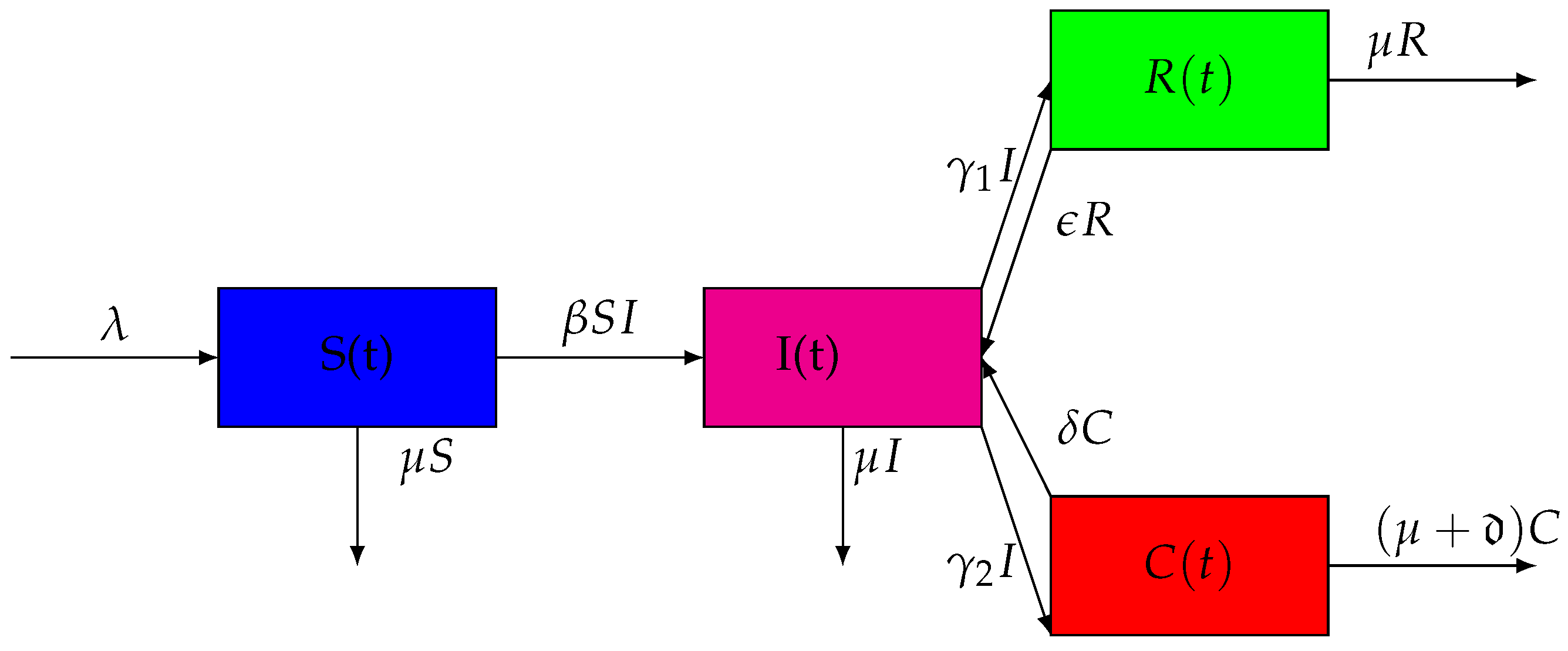
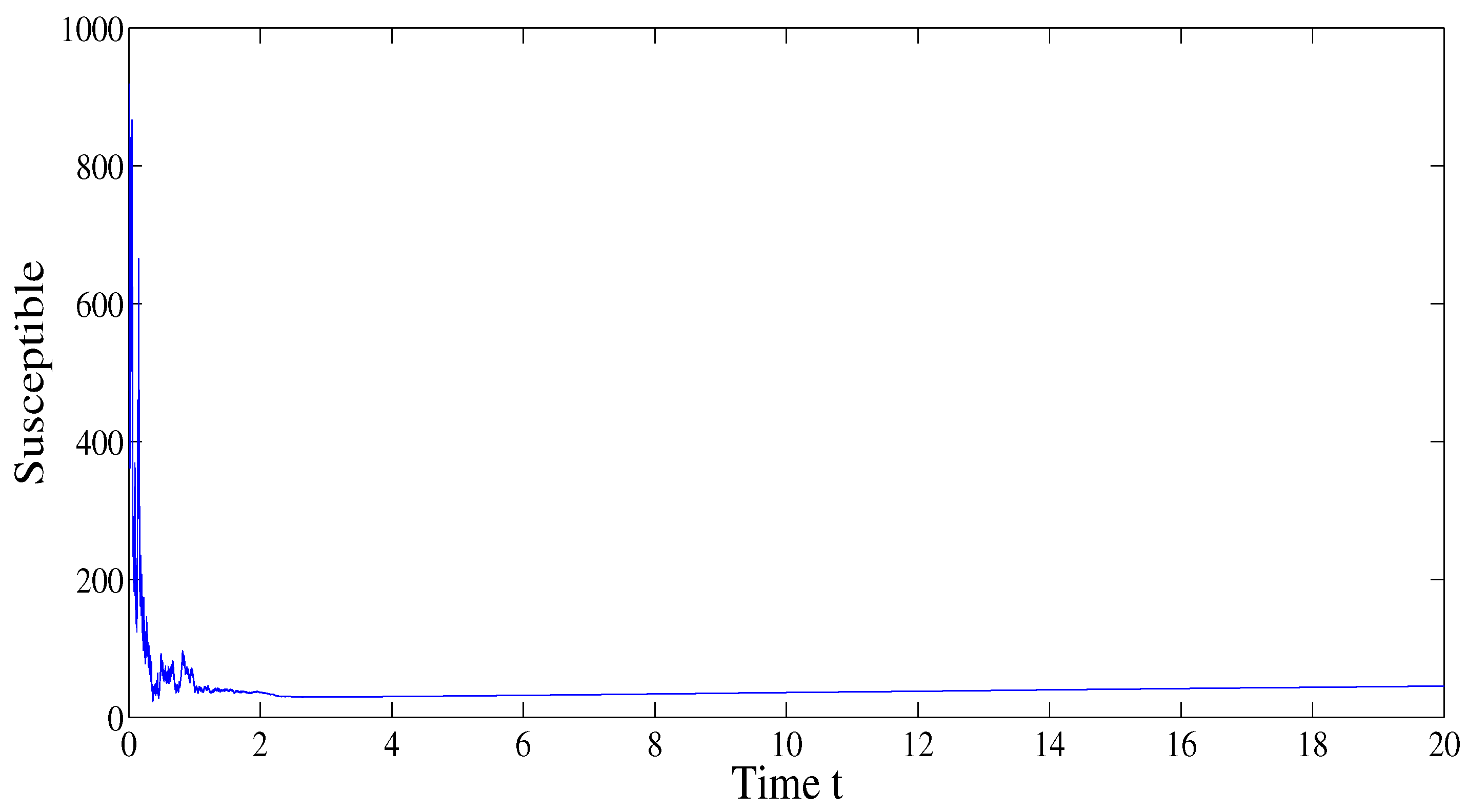
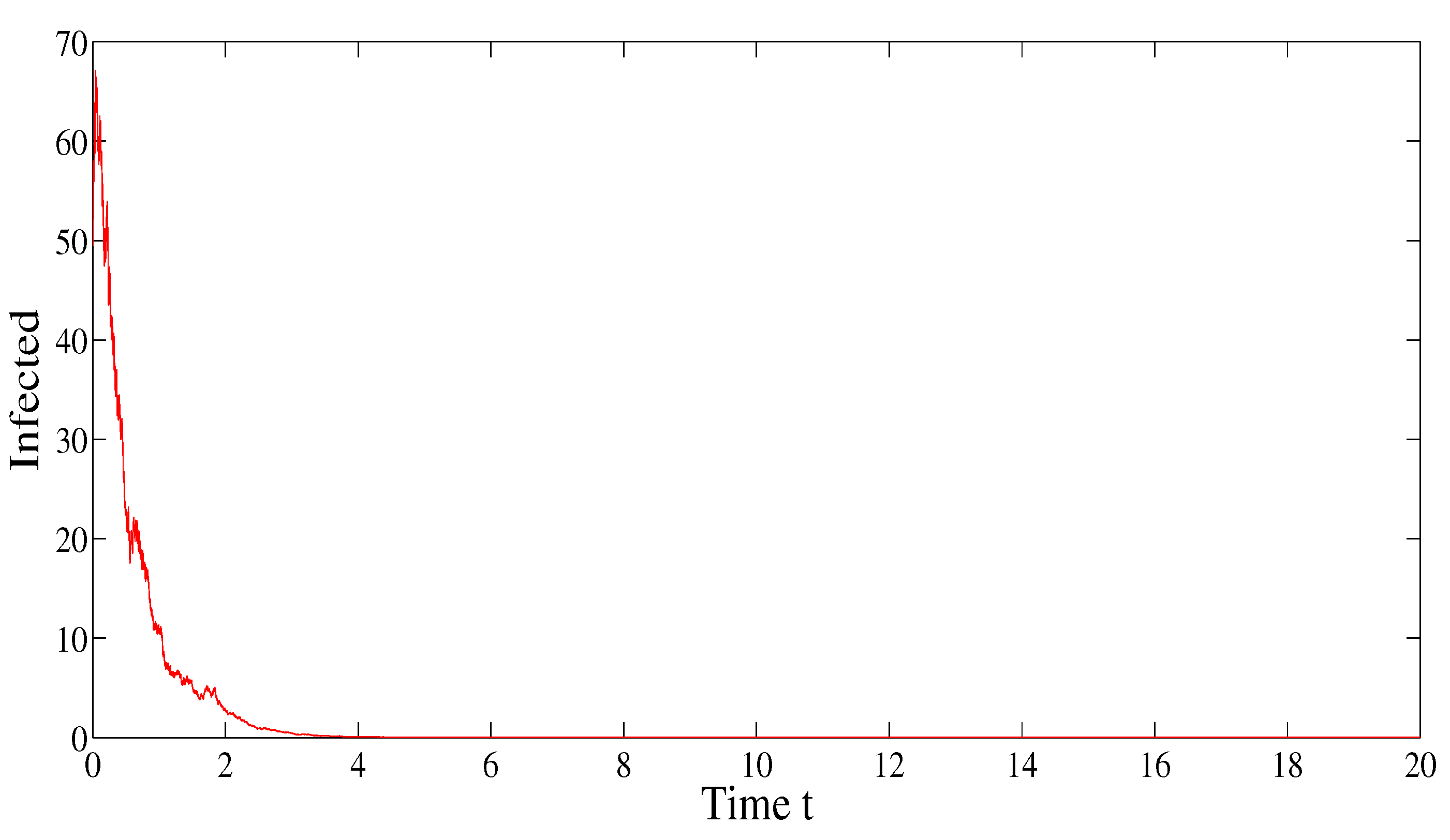
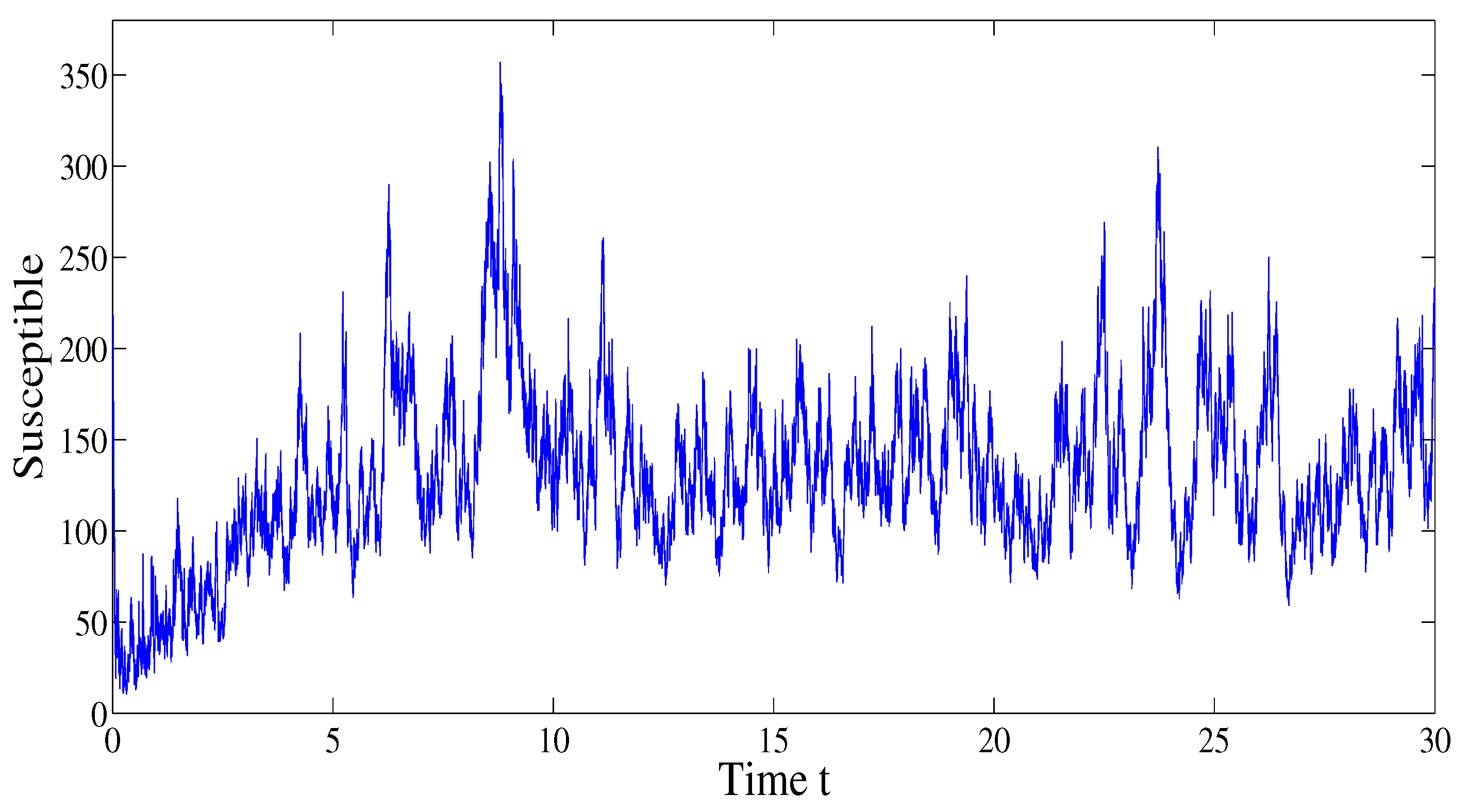
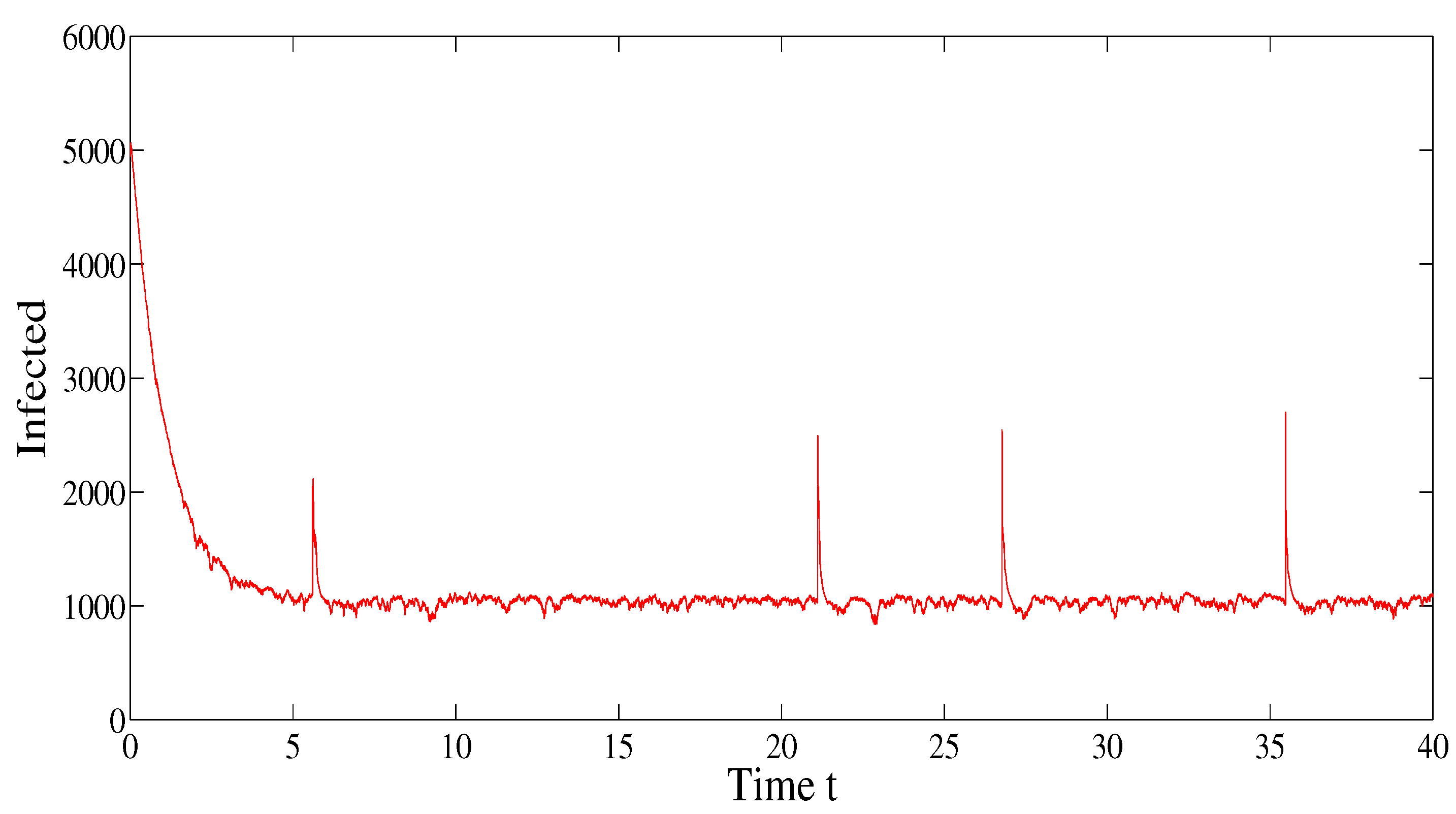
| Parameter | Meaning |
|---|---|
| The recruitment rate | |
| Natural death rate | |
| The transmission rate | |
| The average to the infected I individuals becoming chronically infected | |
| Default treatment rate for I individuals | |
| The average of the recovered individuals returning infected | |
| The average the chronically infected individuals returning infected | |
| Death rate due to the infection in chronic stage |
Publisher’s Note: MDPI stays neutral with regard to jurisdictional claims in published maps and institutional affiliations. |
© 2022 by the authors. Licensee MDPI, Basel, Switzerland. This article is an open access article distributed under the terms and conditions of the Creative Commons Attribution (CC BY) license (https://creativecommons.org/licenses/by/4.0/).
Share and Cite
Srivastava, H.M.; Danane, J. Analysis of a Stochastic SICR Epidemic Model Associated with the Lévy Jump. Appl. Sci. 2022, 12, 8434. https://doi.org/10.3390/app12178434
Srivastava HM, Danane J. Analysis of a Stochastic SICR Epidemic Model Associated with the Lévy Jump. Applied Sciences. 2022; 12(17):8434. https://doi.org/10.3390/app12178434
Chicago/Turabian StyleSrivastava, Hari M., and Jaouad Danane. 2022. "Analysis of a Stochastic SICR Epidemic Model Associated with the Lévy Jump" Applied Sciences 12, no. 17: 8434. https://doi.org/10.3390/app12178434
APA StyleSrivastava, H. M., & Danane, J. (2022). Analysis of a Stochastic SICR Epidemic Model Associated with the Lévy Jump. Applied Sciences, 12(17), 8434. https://doi.org/10.3390/app12178434







